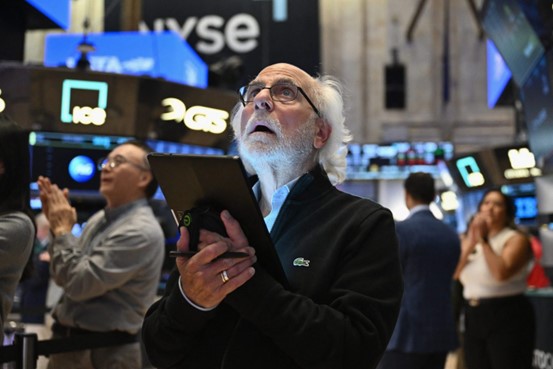
經過華爾街一年多的懇求之后,美聯儲主席杰羅姆·鮑威爾終于暗示,他將開始降息。上周五,在懷俄明州杰克遜霍爾召開的年度研討會上,鮑威爾發表了一段備受期待的主題演講。他表示,他對通脹回落到美聯儲2%的目標越來越有信心,而且美聯儲也不再有理由為了控制通脹繼續維持高利率。
他說道:“政策調整的時機已經來臨。”他指出:“通脹升高風險已經減弱,而且就業下行風險提高。”
在鮑威爾發表演講之前,7月,美國通脹率降至2.9%的三年最低水平,失業率升高到4.3%,由此觸發了一個關鍵經濟衰退指標“薩姆規則”。
鮑威爾強調,兩年多來,美聯儲主要專注于兩個職能中穩定物價的部分,現在則更加關注勞動力市場日益增多的風險。他說道:“我們不希望也不歡迎勞動力市場進一步降溫。”
鮑威爾表示,未來,即將開始的降息的時機和節奏,將取決于新的數據,但他指出“前進的方向是清晰的”。
他說道:“我們將竭盡全力支持強勁的勞動力市場,同時適度減少政策限制,以進一步穩定物價。”他補充說:“我們有充分的理由認為,美國經濟的通脹率將恢復到2%,同時維持強勁的勞動力市場。”
凱投宏觀(Capital Economics)副首席北美經濟學家史蒂芬·布朗表示,鮑威爾上周五演講中“明顯的鴿派”論調,意味著美聯儲在9月份的降息幅度可能達到50個基點,遠超預期,至少如果8月份失業率進一步升高的話。
然而,布朗認為,7月份失業率升高可能是由于“臨時因素”,這意味著除非8月份的就業報告非常糟糕,美聯儲最有可能在下個月降息25個基點。
投資者是否過于樂觀?
GDS財富管理公司(GDS Wealth Management)首席投資官格倫·史密斯也認為,9月份幾乎可以確定美聯儲會降息25個基點。他表示,在鮑威爾發表講話后,隨著美聯儲開始為經濟提供支持,備受期待但經常被忽視的經濟“軟著陸”似乎終于到來。但美聯儲計劃提供多少支持,仍是個未知數。
史密斯通過電子郵件對《財富》雜志表示:“雖然目前來看,9月份降息已成定局,但更重要的是,這是一次性的降息,還是后續降息周期的開始,這將取決于未來兩三個月的經濟數據。”
對于下個月之后的未來政策寬松,市場可能過于興奮。他說道:“我們提醒投資者,歷史上股市曾經出現過對降息過度樂觀的情況。”
惠譽評級(Fitch Ratings)首席經濟學家布萊恩·庫爾頓認同這種觀點。他通過電子郵件對《財富》雜志表示:“目前似乎沒有對于迫在眉睫的經濟衰退風險和失業潮的嚴重擔憂,而這些擔憂可以成為快速降息的理由。相反,工資增長過高導致通貨膨脹居高不下的威脅正在減弱。9月份之后的政策寬松,將是一個循序漸進的過程。”
債券交易商對9月的利率預期,在鮑威爾的新聞發布會后并沒有太大變化。芝加哥商品交易所集團(CME Group)的FedWatch工具顯示,債券市場已經體現了下個月100%降息的可能性,包括有32.5%的概率降息50個基點,在鮑威爾發表講話后情況幾乎沒有變化。
但上周五,股市對鮑威爾的鴿派論調反響積極。道瓊斯工業平均指數上漲1.14%,標普500指數和以科技股為主的納斯達克指數分別上漲了1.15%和1.47%。
另一方面,消費者不會從鮑威爾即將進行的降息中立即受益。銀率網(Bankrate)高級行業分析師泰德·羅斯曼等人指出,美聯儲將逐步降息,這意味著在大多數情況下,消費者借款成本降低的效果需要時間才能顯現出來。
他說道:“我們已經看到抵押貸款利率大幅下降。平均30年期固定抵押貸款利率已經從去年10月的約8%,下降到今天的6.62%。但在過去二十年中,這依舊是相對較高的水平。”他補充說:“我們尚未看到信用卡或汽車貸款利率有明顯下降。”(財富中文網)
譯者:劉進龍
審校:汪皓
經過華爾街一年多的懇求之后,美聯儲主席杰羅姆·鮑威爾終于暗示,他將開始降息。上周五,在懷俄明州杰克遜霍爾召開的年度研討會上,鮑威爾發表了一段備受期待的主題演講。他表示,他對通脹回落到美聯儲2%的目標越來越有信心,而且美聯儲也不再有理由為了控制通脹繼續維持高利率。
他說道:“政策調整的時機已經來臨。”他指出:“通脹升高風險已經減弱,而且就業下行風險提高。”
在鮑威爾發表演講之前,7月,美國通脹率降至2.9%的三年最低水平,失業率升高到4.3%,由此觸發了一個關鍵經濟衰退指標“薩姆規則”。
鮑威爾強調,兩年多來,美聯儲主要專注于兩個職能中穩定物價的部分,現在則更加關注勞動力市場日益增多的風險。他說道:“我們不希望也不歡迎勞動力市場進一步降溫。”
鮑威爾表示,未來,即將開始的降息的時機和節奏,將取決于新的數據,但他指出“前進的方向是清晰的”。
他說道:“我們將竭盡全力支持強勁的勞動力市場,同時適度減少政策限制,以進一步穩定物價。”他補充說:“我們有充分的理由認為,美國經濟的通脹率將恢復到2%,同時維持強勁的勞動力市場。”
凱投宏觀(Capital Economics)副首席北美經濟學家史蒂芬·布朗表示,鮑威爾上周五演講中“明顯的鴿派”論調,意味著美聯儲在9月份的降息幅度可能達到50個基點,遠超預期,至少如果8月份失業率進一步升高的話。
然而,布朗認為,7月份失業率升高可能是由于“臨時因素”,這意味著除非8月份的就業報告非常糟糕,美聯儲最有可能在下個月降息25個基點。
投資者是否過于樂觀?
GDS財富管理公司(GDS Wealth Management)首席投資官格倫·史密斯也認為,9月份幾乎可以確定美聯儲會降息25個基點。他表示,在鮑威爾發表講話后,隨著美聯儲開始為經濟提供支持,備受期待但經常被忽視的經濟“軟著陸”似乎終于到來。但美聯儲計劃提供多少支持,仍是個未知數。
史密斯通過電子郵件對《財富》雜志表示:“雖然目前來看,9月份降息已成定局,但更重要的是,這是一次性的降息,還是后續降息周期的開始,這將取決于未來兩三個月的經濟數據。”
對于下個月之后的未來政策寬松,市場可能過于興奮。他說道:“我們提醒投資者,歷史上股市曾經出現過對降息過度樂觀的情況。”
惠譽評級(Fitch Ratings)首席經濟學家布萊恩·庫爾頓認同這種觀點。他通過電子郵件對《財富》雜志表示:“目前似乎沒有對于迫在眉睫的經濟衰退風險和失業潮的嚴重擔憂,而這些擔憂可以成為快速降息的理由。相反,工資增長過高導致通貨膨脹居高不下的威脅正在減弱。9月份之后的政策寬松,將是一個循序漸進的過程。”
債券交易商對9月的利率預期,在鮑威爾的新聞發布會后并沒有太大變化。芝加哥商品交易所集團(CME Group)的FedWatch工具顯示,債券市場已經體現了下個月100%降息的可能性,包括有32.5%的概率降息50個基點,在鮑威爾發表講話后情況幾乎沒有變化。
但上周五,股市對鮑威爾的鴿派論調反響積極。道瓊斯工業平均指數上漲1.14%,標普500指數和以科技股為主的納斯達克指數分別上漲了1.15%和1.47%。
另一方面,消費者不會從鮑威爾即將進行的降息中立即受益。銀率網(Bankrate)高級行業分析師泰德·羅斯曼等人指出,美聯儲將逐步降息,這意味著在大多數情況下,消費者借款成本降低的效果需要時間才能顯現出來。
他說道:“我們已經看到抵押貸款利率大幅下降。平均30年期固定抵押貸款利率已經從去年10月的約8%,下降到今天的6.62%。但在過去二十年中,這依舊是相對較高的水平。”他補充說:“我們尚未看到信用卡或汽車貸款利率有明顯下降。”(財富中文網)
譯者:劉進龍
審校:汪皓
After more than a year of pleas from Wall Street, Federal Reserve Chair Jerome Powell has finally indicated that he will begin cutting interest rates. In a highly anticipated keynote address at an annual symposium in Jackson Hole, Wyo., on Friday, Powell said that his confidence that inflation is returning to the Fed’s 2% target has grown, and there is no longer a reason to keep rates elevated to fight it.
“The time has come for policy to adjust,” he said, noting that “the upside risks to inflation have diminished and the downside risks to employment have increased.”
Powell’s comments come after inflation fell to a three-year low of 2.9% in July, and the unemployment rate rose to 4.3%, triggering a key recession indicator called the Sahm Rule.
After focusing mainly on the price-stability side of its dual mandate for more than two years, Powell emphasized that the Fed is now more cognizant of rising risks to the labor market. “We do not seek or welcome further cooling in labor market conditions,” he said.
Looking ahead, Powell said that the timing and pace of upcoming interest rate cuts will depend on incoming data, but he noted that “the direction of travel is clear.”
“We will do everything we can to support the strong labor market as we make further progress toward price stability with an appropriate dialing back of policy restraint,” he said, adding “there is good reason to think that the economy will get back to 2% inflation while maintaining a strong labor market.”
Stephen Brown, deputy chief North America economist at Capital Economics, said the “unmistakably dovish” tone in Powell’s on Friday speech is a sign that a larger-than-forecast 50-basis-point interest-rate cut is now possible in September, at least if the unemployment rate rises further in August.
However, Brown argued that the rise in the unemployment rate in July was likely due to “temporary factors,” which means unless August’s jobs report is dismal, a 25-basis-point rate cut next month is the most likely outcome.
Are investors overly optimistic?
Glen Smith, chief investment officer at GDS Wealth Management, also argued that a 25-basis-point rate cut is now all but guaranteed in September. He said that after Powell’s speech, it appears the long-awaited and often-dismissed economic “soft landing” is now finally here, with the Fed coming in to support the economy. But how much support the Fed plans to give is still in question.
“While a September rate cut is essentially a done deal at this point, the more important question is whether this will be a one-and-done rate cut, or if it will be the beginning of a more substantial cutting cycle, and that will be determined by the economic data over the next two to three months,” Smith told Fortune via email.
When it comes to future policy easing after next month, Smith warned, markets may be too excited. “We remind investors that the market has a history of being too optimistic about rate cuts,” he said.
Brian Coulton, Fitch Ratings’ chief economist, echoed that view. “There does not seem to be a serious concern about the risk of an imminent recession and a wave of job losses—i.e., the sort of concerns that could justify rapid rate cuts. Rather it’s about the diminishing threat of elevated wage growth keeping inflation too high,” he told Fortune via email. “The policy easing path post September will be a gradual one.”
Bond traders’ interest rate expectations in September didn’t change much after Powell’s press conference. The bond market was already pricing in 100% odds of a rate cut next month, including a 32.5% chance of an outsize 50-basis-point rate cut, according to CME Group’s FedWatch tool, and little changed after Powell’s speech.
The stock market certainly responded well to Powell’s dovish tone on Friday, however. The Dow Jones Industrial Average rose 1.14%, while the S&P 500 and tech-heavy Nasdaq surged 1.15% and 1.47%, respectively.
Consumers, on the other hand, won’t see an immediate benefit from Powell’s upcoming rate cut. Ted Rossman, senior industry analyst at Bankrate, among others, noted that the Fed will lower interest rates gradually, meaning it will take time to see lower consumer borrowing costs for the most part.
“We’ve already seen a significant drop in mortgage rates. The average 30-year fixed mortgage rate has fallen from about 8% last October to 6.62% today. But that’s still high relative to the past two decades,” he said, adding, “We’ve yet to see a meaningful drop in credit card or auto loan rates.”






